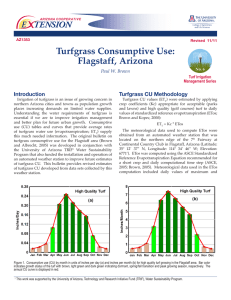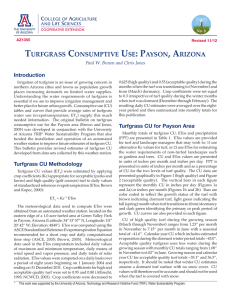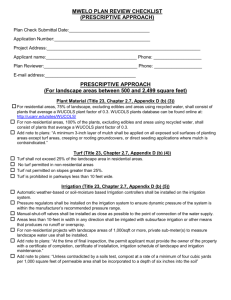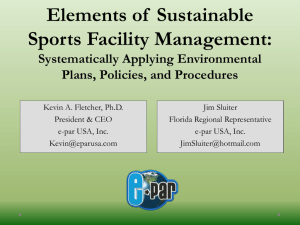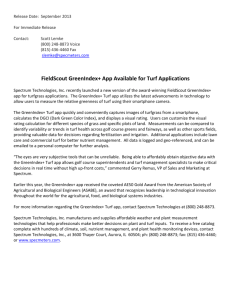Turfgrass Consumptive Use: Prescott, Arizona E TENSION Introduction
advertisement
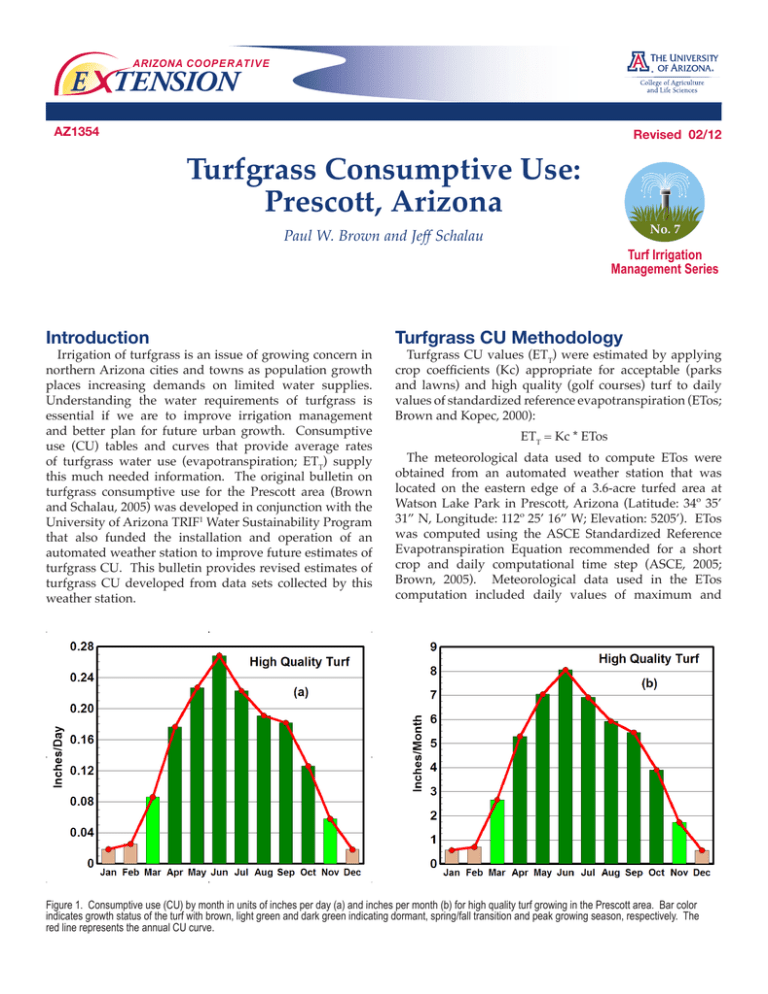
ARIZONA COOP E R AT I V E E TENSION AZ1354 Revised 02/12 Turfgrass Consumptive Use: Prescott, Arizona Paul W. Brown and Jeff Schalau Introduction Irrigation of turfgrass is an issue of growing concern in northern Arizona cities and towns as population growth places increasing demands on limited water supplies. Understanding the water requirements of turfgrass is essential if we are to improve irrigation management and better plan for future urban growth. Consumptive use (CU) tables and curves that provide average rates of turfgrass water use (evapotranspiration; ETT) supply this much needed information. The original bulletin on turfgrass consumptive use for the Prescott area (Brown and Schalau, 2005) was developed in conjunction with the University of Arizona TRIF1 Water Sustainability Program that also funded the installation and operation of an automated weather station to improve future estimates of turfgrass CU. This bulletin provides revised estimates of turfgrass CU developed from data sets collected by this weather station. No. 7 Turf Irrigation Management Series Turfgrass CU Methodology Turfgrass CU values (ETT) were estimated by applying crop coefficients (Kc) appropriate for acceptable (parks and lawns) and high quality (golf courses) turf to daily values of standardized reference evapotranspiration (ETos; Brown and Kopec, 2000): ETT = Kc * ETos The meteorological data used to compute ETos were obtained from an automated weather station that was located on the eastern edge of a 3.6-acre turfed area at Watson Lake Park in Prescott, Arizona (Latitude: 34º 35’ 31” N, Longitude: 112º 25’ 16” W; Elevation: 5205’). ETos was computed using the ASCE Standardized Reference Evapotranspiration Equation recommended for a short crop and daily computational time step (ASCE, 2005; Brown, 2005). Meteorological data used in the ETos computation included daily values of maximum and Figure 1. Consumptive use (CU) by month in units of inches per day (a) and inches per month (b) for high quality turf growing in the Prescott area. Bar color indicates growth status of the turf with brown, light green and dark green indicating dormant, spring/fall transition and peak growing season, respectively. The red line represents the annual CU curve. minimum temperature, daily means of wind speed and vapor pressure, and daily totals of solar radiation. ETos values were computed on a daily basis over a period of seven years beginning on 1 January 2004 and ending on 31 December 2010. Crop coefficients for high and acceptable quality turf were set to 0.95 and 0.80 (Albrecht, 1993; NCWCD, 2003). Crop coefficients were decreased to 0.625 (high quality) and 0.55 (acceptable quality) during the months when the turf was transitioning to (November) and from (March) dormancy. Crop coefficients were set equal to 0.3 irrespective of turf quality during the winter months when turf was dormant (December through February). The resulting daily CU estimates were averaged over the seven-year period and then summarized into monthly totals for this publication. Turfgrass CU for Prescott Area Monthly totals of turfgrass CU, ETos and precipitation (PPT) are presented in Table 1. ETos values are provided for turf and landscape managers that may wish to: 1) use alternative Kc values for turf, or 2) use ETos for estimating the water requirements of non-turfed landscapes such as gardens and trees. CU and ETos values are presented in units of inches per month and inches per day. PPT is presented in units of inches per month and as a percentage of CU for the two levels of turf quality. The CU data are presented graphically in Figure 1 (high quality) and Figure 2 (acceptable quality). The vertical bars in each figure represent the monthly CU in inches per day (Figures 1a and 2a) or inches per month (Figures 1b and 2b). Bars are color coded to reflect the growth status of the turf with brown indicating dormant turf, light green indicating the fall (spring) month when turf transitions to (from) dormancy and dark green identifying the primary or peak period of growth. CU curves are also provided in each figure. CU of high quality turf during the growing season (March through November) ranges from 1.73” per month in November to 8.05” per month in June with a seasonal total of ~47.0”. Calendar year CU which includes estimated evaporation during the dormant winter period totals ~48.8”. Acceptable quality turfgrass uses less water during the growing season with monthly CU totals ranging from 1.52” in November to 6.78” in June. Growing season and calendar year CU for acceptable quality turf totals ~39.7” and 41.6”, respectively. It should be noted that winter CU estimates assume a dormant turf surface with no snow cover. CU values will therefore not be accurate and should not be used when the turf is covered with snow. The CU values provided in Table 1 and Figures 1 & 2 represent gross evaporation rates from turf and do not take into consideration PPT which can reduce or eliminate the need for irrigation in some months. To use CU to determine the amount of water required for irrigation one must first subtract the amount of effective PPT (PPT not lost to deep percolation and runoff) to determine the net water requirement for any period. PPT during the growing season in Prescott averages 13.11” (28-33% of CU) and should reduce irrigation water requirements substantially. PPT often exceeds CU during the winter and should greatly reduce or eliminate the need for irrigation at that time of year. Often, irrigation systems are shut down and drained during the winter months to prevent damage from cold temperatures. The results in Table 1 show this to be an acceptable practice in most years. The final step in determining the irrigation water requirement involves making adjustments to: 1) account for non-uniform irrigation, and 2) ensure leaching is sufficient to maintain soil salinity at acceptable levels. Adjustments for non-uniformity and salinity management increase the amount of irrigation water required and vary dramatically with location due to differences in irrigation system design, topography, local weather conditions and water quality. An irrigation audit is required to assess and properly adjust for irrigation non-uniformity. Water tests are required to Figure 2. Consumptive use (CU) by month in units of inches per day (a) and inches per month (b) for acceptable quality turf growing in the Prescott area. Bar color indicates growth status of turf with brown, light green and dark green indicating dormant, spring/fall transition and peak growing season, respectively. The red line represents the annual CU curve. 2 The University of Arizona Cooperative Extension Table 1. Turfgrass consumptive use (CU) for high and acceptable quality turf, standardized reference evapotranspiration (ETos) and precipitation (PPT) by month for the Prescott area. CU and ETos data are presented in inches per month (“/Month) and inches per day (“/Day). PPT is provided both as monthly totals (“/Month) and as a percentage of turf CU (% CU). Total values for the calendar year (Ann Total) and growing season (GS Total) are provided at the bottom of the table. Winter CU values (Dec-Feb) assume dormant turf with no snow cover. Turf CU Month ETos High Quality PPT Acceptable Quality "/Month "/Day PPT (% CU) "/Month "/Day PPT (% CU) "/Month “/Day "/Month JAN 0.57 0.02 >100 0.57 0.02 >100 1.91 0.06 1.59 FEB 0.71 0.03 >100 0.71 0.03 >100 2.35 0.08 1.79 MAR 2.66 0.09 64 2.34 0.08 72 4.26 0.14 1.69 APR 5.29 0.18 15 4.46 0.15 17 5.57 0.19 0.78 MAY 7.04 0.23 7 5.92 0.19 8 7.41 0.24 0.49 JUN 8.05 0.27 4 6.78 0.23 4 8.48 0.28 0.30 JUL 6.91 0.22 39 5.82 0.19 47 7.28 0.23 2.71 AUG 5.92 0.19 52 4.98 0.16 62 6.23 0.20 3.09 SEP 5.45 0.18 36 4.59 0.15 42 5.74 0.19 1.95 OCT 3.90 0.13 26 3.29 0.11 31 4.11 0.13 1.02 NOV 1.73 0.06 62 1.52 0.05 71 2.77 0.09 1.08 0.02 >100 0.56 0.02 >100 1.86 0.06 28 39.71" 33 51.85" 13.11" 57.96" 17.95" DEC 0.56 GS Total 46.96" Ann Total 48.80" 41.55" determine how much water must be applied in excess of CU to facilitate leaching. References NCWCD. 2003. Crop Coefficient Curve Model. Northern Colorado Water Conservation District [Online]. Available at http://www.ncwcd.org/weatherdata/turfcurve.htm (verified 30 Sep 2011). Albrecht, W. 1993. Turfgrass Water Use in Northern Arizona. Extension Bulletin No. 93-03. The Arboretum at Flagstaff. ASCE. 2005. The ASCE Standardized Reference Evapotranspiration Equation. R.G. Allen et al. (ed). American Society of Civil Engineers, Reston, VA. Brown, P. and D. Kopec. 2000. Converting Reference Evapotranspiration into Turf Water Use. Turf Irrigation Management Series No. 2. Ext. Bulletin AZ1195. The University of Arizona. College of Agriculture and Life Sciences. Brown, 2005. Standardized Reference Evapotranspiration. Ext. Bulletin AZ1324. The University of Arizona. College of Agriculture and Life Sciences. Brown, P. And J. Schalau. 2005. Turfgrass Consumptive Use: Prescott, Arizona. Turf Irrigation Management Series No. 7. Ext. Bulletin AZ1354. The University of Arizona. College of Agriculture and Life Sciences. 1.46 ARIZONA COOP E R AT I V E E TENSION THE UNIVERSITY OF ARIZONA COLLEGE OF AGRICULTURE AND LIFE SCIENCES The University of Arizona College of Agriculture and Life Sciences Tucson, Arizona 85721 Paul W. Brown Extension Specialist, Biometeorology Jeff Schalau County Director, Yavapai County Contact: Paul W. Brown pbrown@cals.arizona.edu This information has been reviewed by University faculty. cals.arizona.edu/pubs/water/az1354pdf Originally published: 2005 Other titles from Arizona Cooperative Extension can be found at: cals.arizona.edu/pubs Any products, services or organizations that are mentioned, shown or indirectly implied in this publication do not imply endorsement by The University of Arizona. Issued in furtherance of Cooperative Extension work, acts of May 8 and June 30, 1914, in cooperation with the U.S. Department of Agriculture, Kirk A. Astroth, Interim Director, Cooperative Extension, College of Agriculture and Life Sciences, The University of Arizona. The University of Arizona is an equal opportunity, affirmative action institution. The University does not discriminate on the basis of race, color, religion, sex, national origin, age, disability, veteran status, or sexual orientation in its programs and activities. The University of Arizona Cooperative Extension 3
